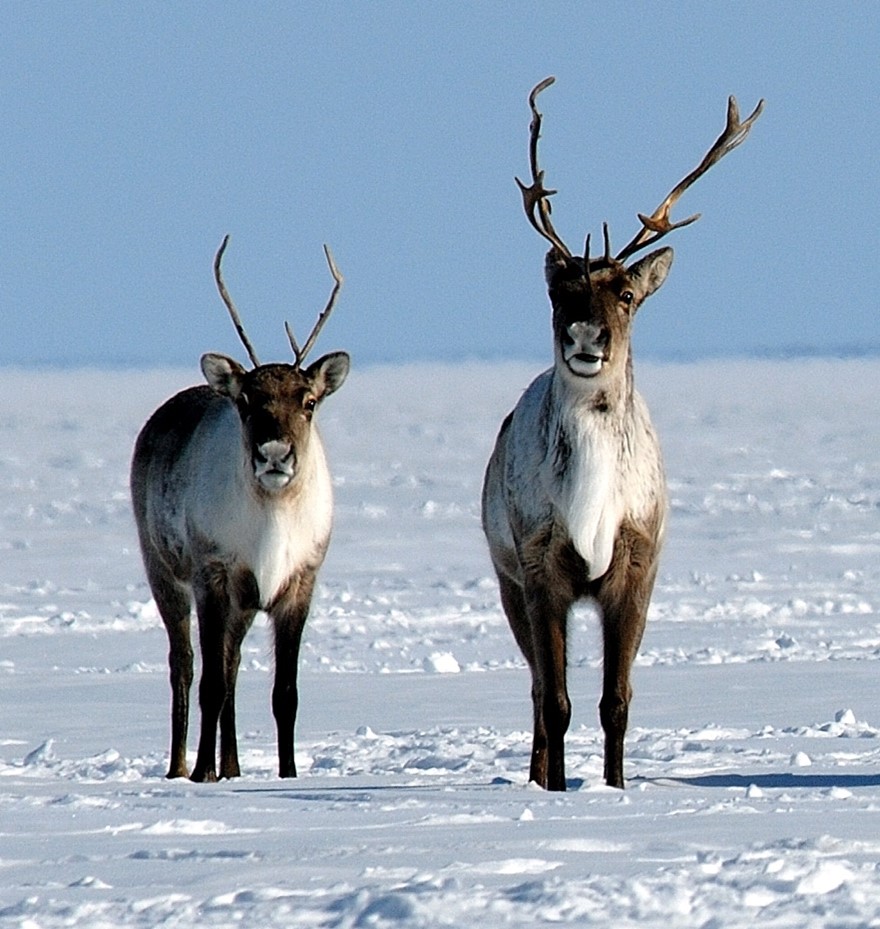How is rapid change in the Arctic affecting caribou?

Caribou from the Bluenose East herd, whose range is in western Nunavut and the Northwest Territories. Estimated at 104,000 animals in 2000, the population dropped to about 19,000 in 2018. The herd is thought to have increased slightly in 2021.
Photo: John Nagy / GNWT
How are Canada's caribou herds faring in the face of a warming climate and other rapid changes in the north? What does the future hold? Two groups of caribou experts—Indigenous hunters and wildlife biologists—have combined their knowledge to provide answers as part of Polar Knowledge Canada's Collaborative Assessment Project.
Inuit and other northern Indigenous peoples have always depended on caribou. Caribou meat is highly nutritious, and caribou-skin clothing has kept generations of Inuit comfortable through the bitter cold and high winds of countless arctic winters.
Northern Indigenous peoples can depend on caribou because there are usually enough to meet their needs. However, they are well aware that this is not always the case. Inuit oral histories speak of times when migrating caribou did not arrive as expected. There are people alive today who remember the devastating famines that ensued. There is a strong link between the health and abundance of caribou herds and the health and well-being of many northern communities.
Caribou herds grow and shrink naturally over 30 to 65 years. Their predators—such as wolves, grizzlies and black bears—rise and fall along with them. In recent years, many caribou herds have declined. Others are maintaining a moderate size, and one, the Porcupine herd in the western Arctic, has grown large.
Caribou face new challenges caused by humans, including climate change, industrial development, and modern hunting methods, to name a few. These challenges can prevent or slow herd recovery — or cause further decline. Caribou biologists have gathered a considerable amount of data on how caribou cope with their environment, primarily from radio-collar tracking. A computer model, the Caribou Cumulative Effects Model, uses this information to show how climate and industrial development affect caribou.
Inuit elders have described how, when caribou are falling in number and food is scarce, the animals move around, searching for better foraging areas. A few manage to find places where they can survive and regain their strength. Caribou eventually repopulate their original habitat once the vegetation recovers, which can take about 20 years. It is important to use Indigenous knowledge to identify, map, and protect these areas to help caribou herds recover.
Caribou eventually repopulate their original habitat once the vegetation recovers, which can take about 20 years. It is important to use Indigenous knowledge to identify, map, and protect these areas to help caribou herds recover.
Community Hunters and Trappers Organizations have often taken action to conserve caribou during times of scarcity. Some have closed sport and commercial hunting, while keeping the subsistence hunt open. Caribou management boards have limited harvests, and are recommending more harvest reporting. Some governments have imposed caribou hunting bans until long-term conservation measures can be developed. Others have established natural reserves in areas important to caribou migratory routes and crucial lifecycle stages such as calving. These are positive steps, but more work is needed.
Stronger conservation measures, developed through co-management, can protect caribou herds and their habitat. Traditional Indigenous hunting methods are ecologically sustainable and a good starting point for building new co-management systems. Decisions on land use and harvest can either help or hinder caribou health. Caribou management plans need to protect caribou from disturbance, especially during the calving and post-calving seasons.
Stronger conservation measures, developed through co-management, can protect caribou herds and their habitat. Traditional Indigenous hunting methods are ecologically sustainable and a good starting point for building new co-management systems.
Individuals, communities, Indigenous and scientific knowledge holders, organizations, and governments all want to see healthy caribou herds. Cooperation is essential to maintaining the vital link between caribou and healthy northern communities.
Polar Knowledge Canada
For media inquiries, contact:
communications@polar-polaire.gc.ca